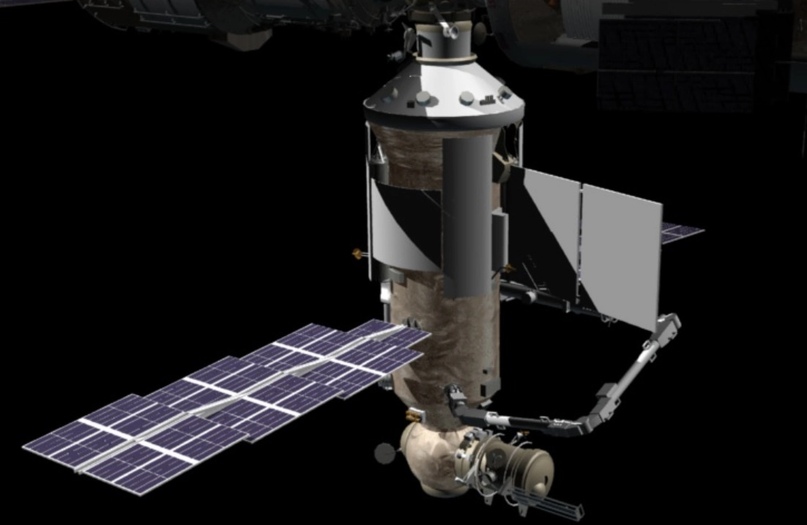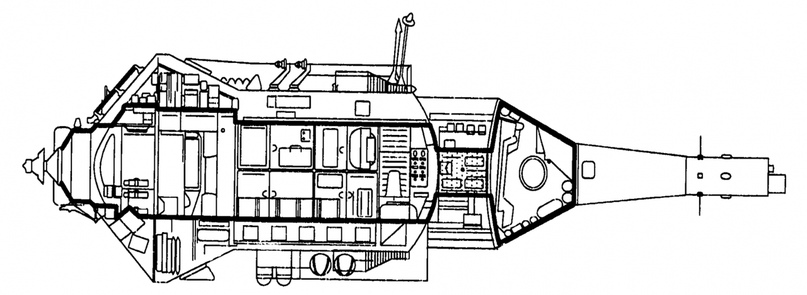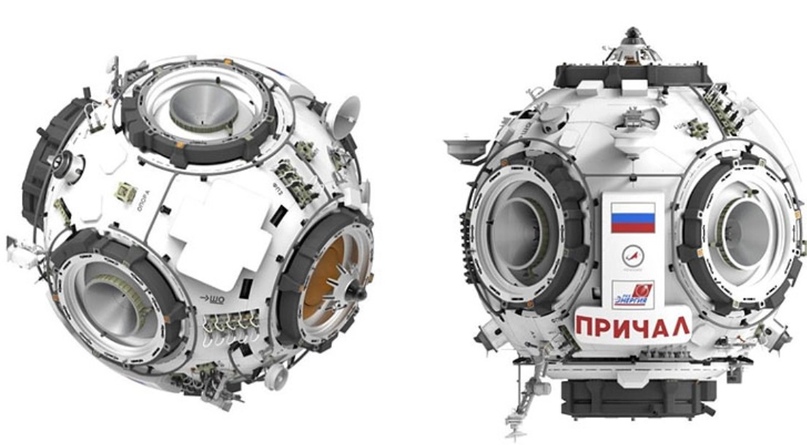Caution - this is an adapted google translation. Original article on NSF portal.
Without the groans familiar in Russian publications about the "antiquity" of the Science module and other black PR

The newest manned module of the International Space Station (ISS) "Nauka" has arrived at the Baikonur Cosmodrome in Kazakhstan for final inspection and preparation before launch. The launch of the module, which has been delayed for more than 13 years, will usher in a new phase of the station's expansion.
Currently, the "Science" module is planned to be launched on the "Proton-M" launch vehicle in April 2021. The new module will be docked to the ISS in the place where the Pirs docking module is currently located.
History of "Science"
The module, which later received the name "Science", was first built as a backup for the "Zarya" module, which is currently in orbit. Therefore, both have a similar design called the "Functional Cargo Block" (FGB).
The design of the FGB goes back to the Soviet spacecraft TKS, which was designed in the 1960s for use as a crew and cargo delivery vehicle for the Soviet Salyut space stations. It consisted of two parts - the VA spacecraft and the functional cargo block, which could operate independently.

Sectional diagram of the TKS spacecraft. The sealed volume is outlined. The cylindrical FGB is left and center, while the conical VA and maneuvering system are visible on the right. Credit: NASA.
The VA spacecraft itself was originally developed as a lunar vehicle - an analogue of the Apollo command module. During launch and landing, it had to carry three crew members on board and was notable for being intended for reuse, although this was demonstrated only once in practice.
For lunar missions, the VA was to be launched on a Proton rocket with an additional service module attached to support a longer lunar mission. However, this configuration was canceled in favor of the Soyuz 7K-L1 project (known as the Probe), which flew 12 times in space. After it was rejected for the Soviet lunar program, the VA was repurposed to become part of the TKS (Supply Transport Ship) spacecraft.
The functional cargo block in this design served as a service and storage module. In the center, it had a capacious sealed volume designed for storing goods and equipment. Outside the FGB were fuel tanks, maneuverable engines, solar panels, and a docking port.
TCS flew four times and docked three times with the stations of the Salyut project. But none of these missions had a crew.
After the cancellation of the TKS program, the Soviet space program soon took advantage of other possibilities that the proven design of the FGB could offer.
In 1987, the Kvant-1 module was launched to the Mir space station. Instead of having its own control system, it was delivered to the station using a functional service module built on the basis of the FGB.
Several other modules of the Mir station were themselves derived from the FGB, including the Kvant-2, Kristall, Spektr and Priroda modules. The use of the FGB design in the construction of the Mira modules saved time and money.
Later, in 1987, the Polyus spacecraft was launched in the first flight of the Energia launch vehicle. The Pole was the prototype of an orbital laser weapon designed to destroy satellites. It was controlled and powered by a modified FGB, a remnant of the TCS program. Due to a malfunction in the FGB control system, the Pole was oriented incorrectly before starting the engines. The Pole failed to enter orbit and burned up over the Pacific Ocean.
In 1998, the next module based on the FGB, Zarya, was launched on the Proton launch vehicle. Zarya became the first module of the International Space Station to provide power, control and orientation for the first station. It was built by Russia under a contract with NASA.
In case of an unsuccessful launch from spare parts, they began to build a backup copy of the Zarya module. The construction of the module, called FGB-2, was stopped at about 70% readiness.
After the successful launch of Zarya, FGB-2 was put into storage with no definite future. Several plans have been proposed for integrating the module into the ISS. These included options for a docking port, laboratory, or even a disposable resupply transport ship.
In the end, Roskosmos - the Russian space agency - made the decision to rebuild FGB-2 into a "Multipurpose Laboratory Module," or MLM. The module was planned to be launched in 2007.
As the name suggests, MLM will be a multipurpose (mostly scientific) module. It will include, among other things, crew quarters, scientific and research work spaces, a propulsion system, solar panels, a robotic arm called the European Robotic Arm, and an experimental airlock.

However, not all elements will be launched into orbit with MLM.
The Rassvet mini-research module was launched to the ISS in 2010 aboard the Atlantis spacecraft. The module was conceived as a small docking laboratory module. In addition, Rassvet was instructed to deliver several components for MLM to the station.
Dawn is launched on Atlantis with an MLM radiator, an experimental airlock and a spare connection for a European robotic arm - all of which will be installed on the MLM module after it arrives at the station.
MLM will also have propulsion systems sufficient for rendezvous and autonomous docking with the ISS after launch. Once connected to the station, the onboard fuel tanks can be reused for fuel storage. MLM solar panels will also help reduce the dependence of the Russian segment on the plant's main solar array, which is technically part of the US segment.
The new module will be equipped with water and air purification systems, a new galley and toilet. Its engines can also be used as standby ones to control the station in case of failure of the engines on the Zvezda module.
Later MLM was officially named "Science"
After commissioning and equipping, Nauka will become the main laboratory module in the Russian segment. There are currently two small laboratory modules in Russia - Rassvet and Poisk, both of which are in no way inferior to Science.
In addition, Nauka will receive the title of the heaviest Russian module at the station - 24.2 tons. Currently, this honor belongs to the Zvezda module - 20.3 tons.
The future docking port for Nauka on the ISS - Zvezda Nadir, or the Earth-facing docking port - is currently occupied by the Pirs docking module.
Pirs was launched in 2001 and serves as a docking hub for the Soyuz and Progress spacecraft. In addition, it has storage space and two hatches for space walks.
The Progress cargo ship will be used to free up the docking port for Nauka. He will remove Pierce from the station. This is planned to be carried out by the Progress MS-15 spacecraft, which was launched in July 2020 and docked at Pirs three hours later.
The Russian crew at the station will make a spacewalk to prepare the Pirs module for removal. At the end of the Progress MS-15 mission - provided that Nauka is ready for launch in April 2021 - instead of undocking Progress from Pirs, the hooks and latches connecting Pirs and Zvezda will be removed , and Progress will release the docking station from the station.
A few days later, Progress would leave orbit from Pirs to re-enter Earth's atmosphere.
The Pier will be the first station module to be permanently removed and destroyed. There are currently no plans to remove any other original modules from the station on either the Russian or the US (including Canada, Japan and ESA) side of the station.
But "Science" will not be a one-time addition, but will open an era of large-scale expansion of the station.
In the third-fourth quarter of 2021, the “Prichal” module will be launched at the station - translated from Russian as “pier” or “dock”. It will be delivered in a modified Progress spacecraft and docked at the Earth-facing port of Nauka.

Rendering of the Node Node "Jetty". The top port in the right view will be connected to the Earth-facing Nauka port. Credit: RSC Energia.
The Prichal has six docking ports, one of which will be used for Nauka. The remaining five will be available for visiting the Soyuz or Progress ships, and later for additional new modules. The port directly opposite Nauka is equipped for pumping fuel to the station from Progress ships.
When the Prichal leaves for the ISS, it will carry one ton of cargo with it.
The first permanent module, which will be used by one of the ports of the Prichal, will be the HEM-1 Scientific Energy Module.
HEM-1 is a completely new design, consisting of two segments - one hermetic and one non-hermetic.
The cylindrical sealed segment will have an internal volume that exceeds the volume of "Science". It will contain a modular storage system for research, crew quarters and storage - similar to the modules in the US Orbital Section. The modular system makes it easy to reconfigure internal elements.

Visualization of HEM-1. The wide sealed section is visible at the bottom left, and the smaller unsealed section (with two large solar panels) in the center. Credit: RSC Energia.
The pressurized HEM-1 segment will also house a new life support system and additional crew accommodation.
Communications equipment, radiators and two large solar panels will be installed in the leaky segment. They will generate 18 kilowatts, 12 of which can be sent to other modules in the Russian segment. New antennas on HEM-1 will provide continuous communication via Russian relay satellites.
The construction of HEM-1 has faced limited funding since 2016. However, Russian officials are still planning to launch it in 2021 or 2022.
In 2019, structural tests of the module's ground test sample were completed.
HEM-1 will be launched on a Proton-M launch vehicle with a non-standard fairing. The walls of the sealed segment will remain open and the conical fairing will cover the docking port. A separate cylindrical cover will cover the leaky segment.
Additional Russian modules have also been proposed, such as an airlock and a self-contained, free-flying laboratory module. These plans are still in the early stages of development.
On the US side of the complex, Axiom plans to add a modular complex to support the station's commercial and industrial use.